As an Amazon Associate I earn from qualifying purchases.
This is an old school, slow roast duck recipe, the way your grandma might have made. If you have a store-bought duck or a really fat wild duck, this is the recipe for you.
Roasting a duck this way will give you crispy skin, much of the fat will render out, bathing the root vegetables underneath, and the whole bird will be cooked through.
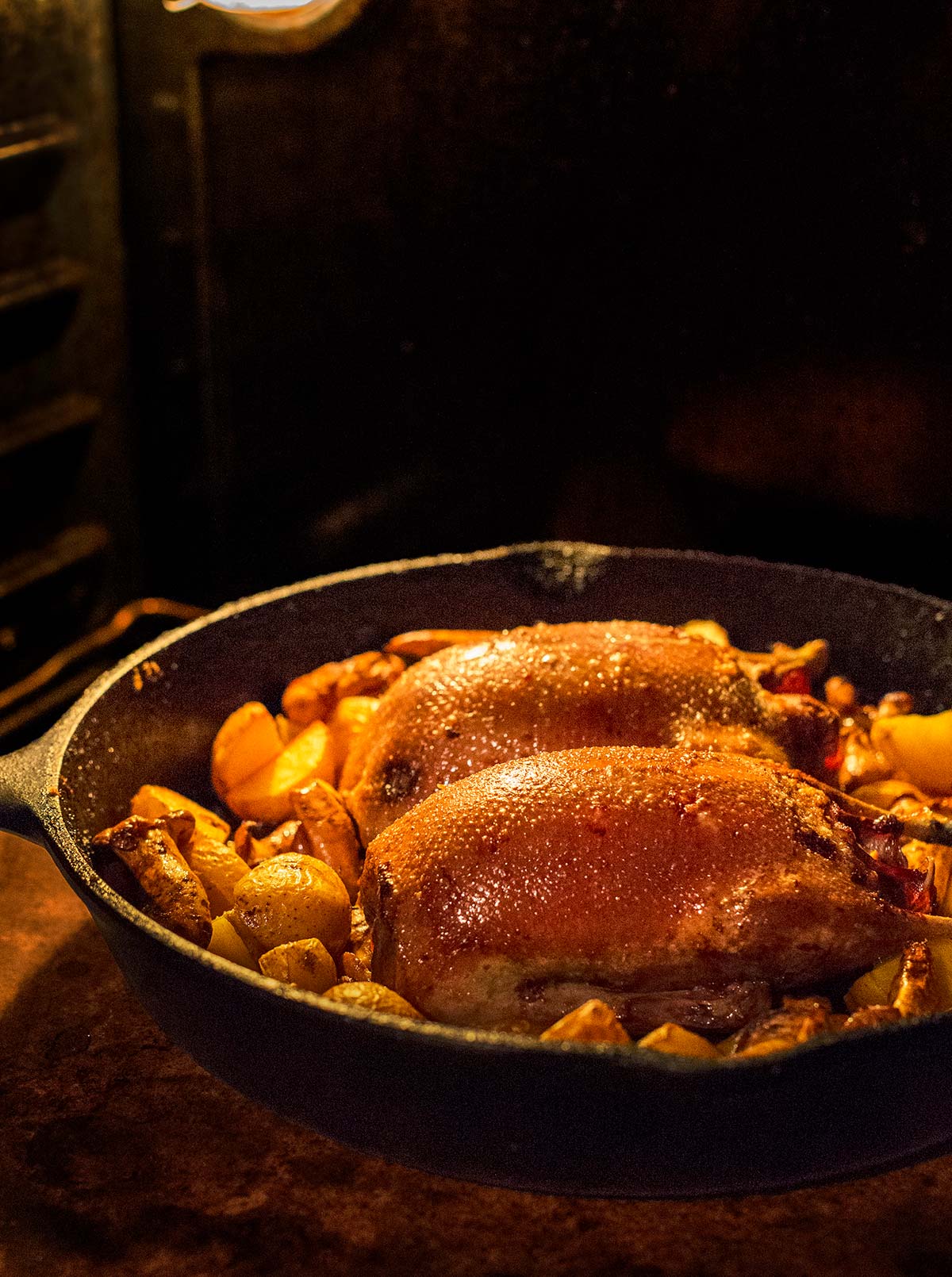
This is how pretty much everyone made roast duck until relatively recently, when the glories of duck served medium or medium-rare began to be more well-known. Yes, you can absolutely serve duck — or goose — rare, or even raw, if it’s of good quality. Food-borne illnesses from waterfowl are very, very rare, unlike with chickens and turkeys.
So if you happen to have a wild duck, or a lean farmed duck — Indian runners and Muscovy ducks can sometimes be quite lean — you are better off using my other recipe for roast duck, which is geared specifically for lean, and wild birds.
This method, slow roast duck, is the way all of Europe has been doing it for millennia, so there’s some history here. I go into it in more detail in my cookbook Duck, Duck, Goose: The Ultimate Guide to Cooking Waterfowl, Both Farmed and Wild, an entire cookbook dedicated to waterfowl.
The reason it works is fat. Fat is an insulator, and in a duck it’s all underneath the skin. You need to render that fat or the skin will never get crispy. And rendering fat from an obese duck takes time — so much time that your breast meat will be fully cooked by the time it’s ready (The legs and wings will be perfect, though).
I should tell you that I don’t love fully cooked breast meat; I prefer it medium-rare. It gets a bit livery and, at least to my mind, essentially becomes a vehicle for gravy.
You can do two things about this: You can slice off the breasts when they reach an internal temperature of about 135°F, then sear just the skin side in a pan before serving, or you can live with fully cooked breast meat and make a damn good gravy. (Follow the technique for the gravy in my poached turkey recipe, only subbing in duck or goose bits.)
Even fully cooked, the breast meat will still be moist because it’s been bathed in its own fat for an hour or more, so it’s not as if it will be inedible. And some people prefer it that way.
A few tips: Do not cover your duck when roasting because you want that crispy skin. If you cover it, the bird will steam.
And, you will know a roast duck is ready when the legs feel loose, the fat runs clear, and the skin is crispy.
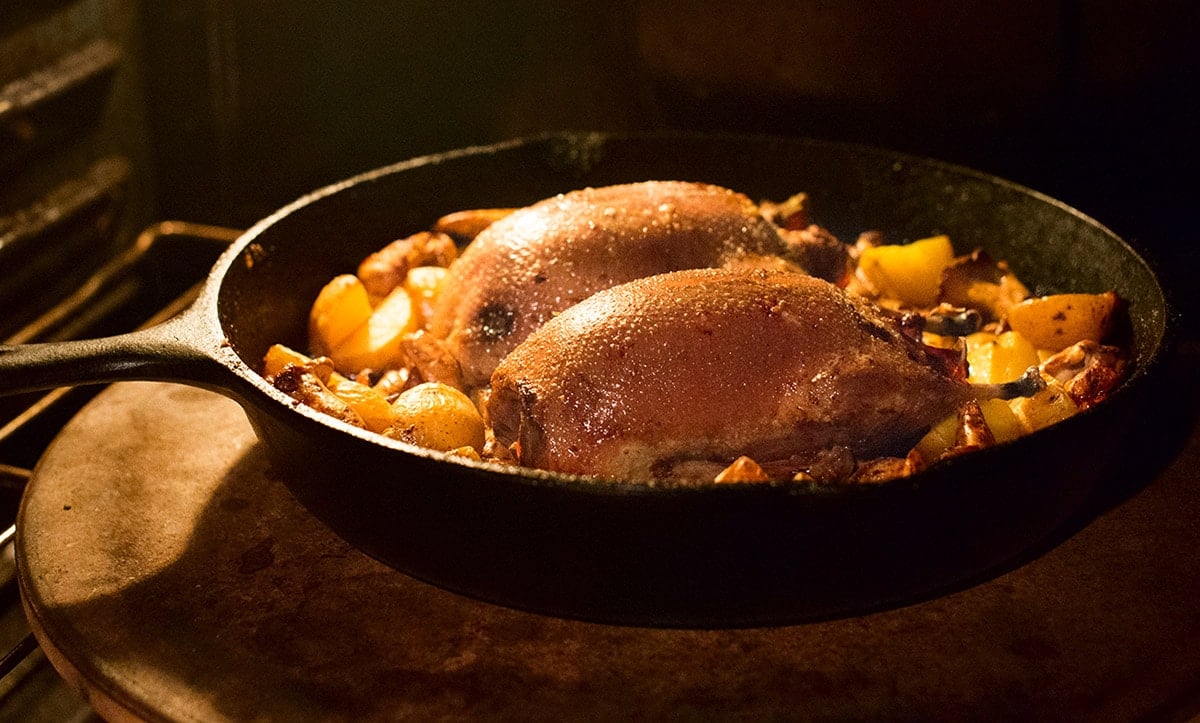
With this recipe, err on cooking the bird longer, not shorter. As the cook, remember that the legs and wings will be the best parts. Distribute them accordingly.
My advice for when you make slow roast duck this way is to roast them over the top of lots of root vegetables, the more varied the better. And think about a gravy or a sauce to go with it. I have a large selection of wild game sauces here you can choose from. Other than the gravy I mentioned above, I might suggest the maple-bourbon gravy for starters…
Slow Roast Duck
Ingredients
- 1 domesticated duck or 2 very fat wild ducks (see above)
- 1 tablespoon kosher salt
- 1 lemon, cut in half
- 4 sprigs sage, rosemary, parsley or thyme
Instructions
- Set your oven to 325°F. Using a needle or a sharp knife point, prick the skin of the duck all over -- but be sure to not pierce the meat itself, only the skin. This lets the fat render out and will help crisp the skin. Pay special attention to the back, the flanks, and the very front of the breast.
- Rub the cut lemon all over the duck and stick it inside the cavity. Liberally salt the bird; use a little more salt than you think you need. Stuff the duck with the herbs. Let the bird sit out for about 30 minutes to come to room temperature, while the oven heats up.
- When you are ready to roast, put the duck in an iron frying pan or other ovenproof pan and surround it with root vegetables. Set the pan in the oven. Small ducks (wood ducks, wigeon, teal, ruddies, etc.) only need 40 minutes in the oven. If you are roasting mallards or a typical, store-bought Pekin duck, you will want to increase the roasting time to 90 minutes. A goose may take as long as 2 hours. After the allotted time, take the pan out of the oven and set the ducks on a cutting board to rest. Spoon any fat that has accumulated over the vegetables and salt them well. If the veggies are ready to eat, remove them. If there is a lot of excess fat, spoon it off.
- Now increase the heat to 450°F. When the oven hits this temperature, return the birds to the oven and roast them for up to 30 more minutes, or until the skin is crisp. The reason you take the bird out of the oven is because a) the resting time helps redistribute the juices in the bird midstream, and b) you are crisping skin without totally overcooking the duck by only returning it to the oven when it is hot.
- Remove from oven and let the birds rest. Small ducks need 5 minutes resting time, large ducks 10 minutes, geese 15.
Nutrition
Nutrition information is automatically calculated, so should only be used as an approximation.

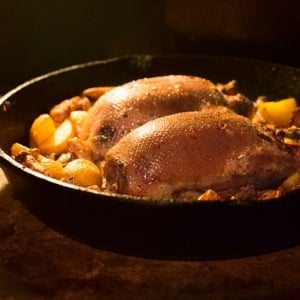

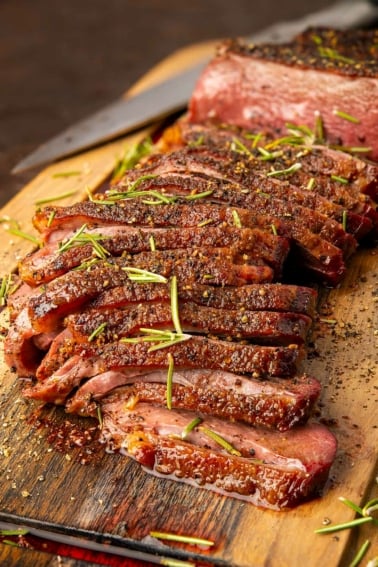
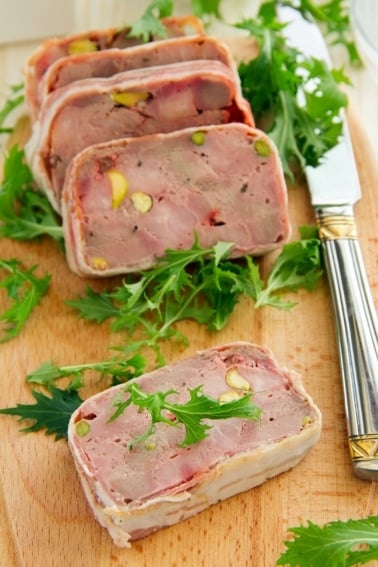

This recipe is great! The duck was just perfectly delicious! Thanks.
Thank you for this wonderful and easy to follow recipe. It’s been years since I roasted a duck and it came out beautifully.
I followed this recipe this evening and was not expecting the end result. If anything, the wild duck breast was too rare!!
Absolutely wonderful result; deep colours, dark meat with lots of flavour.
Will definitely be using this again. Many thanks.
What about if I roast the duck for 1 hour remove the breasts they should be rare, then finish cooking the duck the rest or the way by the recipe. If the breast need browned or cooked more I can sear the skin either under the broiler of pan sear and brown them and try not to over cook the meat. What do you think of my idea?
Chuck: The breasts won’t be rare at 1 hour, they will be well done. I do the method you are describing with geese, and it works. Use a meat thermometer to gauge doneness in the breast before you cut it off.
Hi,
I have never roasted a duck before and one thing that I am concerned about and would like more detail on is the cooking time. I only ask because most of the other recipes I see roast the duck a lot longer. For instance, like 10-15 min at 500 degrees and then 3-4 hours at 300 degrees. 300 is only slightly cooler than 325 so that is why I am concerned.
Thanks!
I am extremely partial to your hot and quick roast method and use it for almost all of the ducks I harvest. But if one were to do it this way, could the cavity be stuffed with a cornbread dressing or something similar?
Edward: You bet. I really only use this method for very fat ducks.
I just made this recipe and it is delicious! I was clean out of wild ducks so I used the one I bought at the store. If nothing else, the vegetables (I used golden potatoes, sweet potatoes, beets, carrots and parsnips) are magical. I put garlic powder, celery seed, salt and pepper and they are so good! The duck is delicious! Thank you!
We raised Pekin ducksnthis spring. However, they are small, just 3-4 pounds (processed) and hard to cook. I have been reading your recipes for wild ducks. Do you think we should treat them more like wild ducks when cooking? What weight are the birds for yournSlow Roast Duckmrecipe?
I just bought a duck with the neck still attached inside its cavity!! I tried cutting it out but it’s impossible so I’m going to take a chance and cook it. Have you ever heard of this??
Alexis: Huh. Nope. Never heard of that.
I purchased a domestic goose (10lb) and came here for cooking advice. Glad I did. The directions are easy to follow and thankfully didn’t require me to hunt down unusual ingredients. Although Hank occasionally calls for esoteric bits, most of the recipes here are simple, for us simple hunter-folk to use.
The highlight of the meal was the skin. I’ve never had a skin so crispy and perfect. The combination of lemon juice and salt along with the fat leaking from the pinpricks really flavored up that tasty crust, and the cooking temps and times were perfect.
I also agree with Hank observation about the difficulty of getting whole birds just right so I’ll not order another whole bird and use it that way. The breast and back meat was great, but the legs were a little tough and the skin on the under-parts was not crispy. It would have been much easier and better enjoyed by my family if I’d have just given each their own goose breast, tasty skin and all.
Surprisingly, the vegetables were tough; perhaps not fully cooked? They were in the pan with the goose for the full roasting and browning time, most of that spent submerged in goose fat. Hank, did the fat slow down the cooking perhaps? I failed to pour off the fat before the browning phase…
Wonderful recipe. Thanks!
Pen: Huh? That is nothing at all like this recipe.
Well it sort of is. It uses a duck. But you’re right. My only excuse is I started on the recipe to render the fat from the duck skin and moved to this recipe but I should have put my attempt at a different way to render the fat back on the other recipes site. Feel free to move it there or to another place you feel is more appropriate or delete it if you find it all inappropriate. I just thought I’d try a completely different way to render the skin’s fat and still end up with as rare a piece of meat as you can stand. The heat gun didn’t work but the other method did and gave a very rare breast.
OK, I tried it. I had two boneless Pintail halves and two Shoveler. I tried the heat gun on one Shoveler half and it took 10 minutes on low to get most of the breast fat off holding the gun and directing the air…too long. The fat pintails would take 1/2 hour each half because you could only use the low setting. The high was too hot and burned the skin.
Back to the old method of low heat skin side down with the legs and thighs cooked separately in the rendered fat. I use a s.s. pot’s weight to press down on the breasts when they were rendering and again when the meat side cooked when I turned them. I got perfect rare for me and medium rare “HER.”
Pen: Huh? That is nothing at all like this recipe.
I’ve got a need to save as much duck fat as possible while keeping the meat as under done as I can which usually ends up medium rare. I’m going to try to have it both ways by filleting all the meat off the carcass resulting in two half ducks that can lay flat. I’m going to score the skin and then take a heat gun (it goes from 500 on low toover 1,000 deg. on the high setting) and crisp the skin to get the fat out hopefully leaving the meat uncooked to a large extent. On the barbi for a minute meat side down and rest it. WAAAY more trouble I think than any other method but if it works I’ll have the best of all worlds. A cup of fat, crispy skin and rare meat. We’ll see.
Doing this weekend with my mallards and bourbon and maple syrup gravy.
Cheers.
Mark
I’m wondering how this would work if I roast them this way the night before, and heat them up before serving?
Oh my… this looks so delicious. I’m going to practice making this so I can impress my guests the next time we have company.
anybody stuff their birds?
my very old-time hunting partner stuffs his with fully cooked wild rice, onions, and lemon. he also slathes the bird in butter first, BUT he grills his on the BBQ
my gunsmith swears by white bread soaked in red wine and oranges!!
I did a ton of ducks this way this last season. It was so easy and so good that I just couldn’t get tired of it. I would pluck a limit and pick out 1-2 of the very finest specimens for roasting – meaning least shot up with the most and the whitest fat.
Most of the time I used 1 fresh sprig of each of those 4 herbs with a lemon. That combo of those flavors with the kosher salt and the duck was fantastic. I did try an orange on my last go and it was good, too.
I was doing 300 for 45, then 500 for 10 (I even discovered that my oven went over 500 and did one for 10 min at 510!). Usually mallards, but I did do a pair of pintails as well. My breast meat was coming out about medium. The legs and wings were a little on the tough side, but still awesome. Yeah, I’m a leg-man.
My favorite part though is scavenging the carcass for all the little leftover niblets and pockets of meat that most folks will never know exist!
I had duck for the first time since I remember last night and thought about what you said about the difference between store-bought and wild-caught duck, how it’s apparent just in the colour of the meat. I felt a bit guilty, but found comfort in the fact that this was a small chichi-foofoo restaurant known to stock ingredients fresh daily.
Yup. Cook all of my ducks this way. 🙂